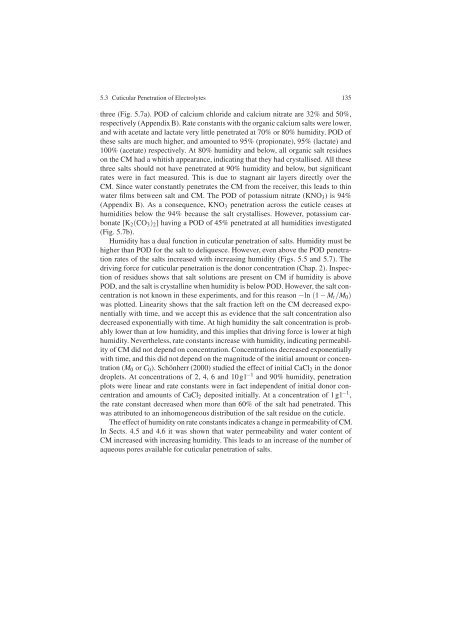Water and Solute Permeability of Plant Cuticles: Measurement and ...
Water and Solute Permeability of Plant Cuticles: Measurement and ...
Water and Solute Permeability of Plant Cuticles: Measurement and ...
Create successful ePaper yourself
Turn your PDF publications into a flip-book with our unique Google optimized e-Paper software.
5.3 Cuticular Penetration <strong>of</strong> Electrolytes 135<br />
three (Fig. 5.7a). POD <strong>of</strong> calcium chloride <strong>and</strong> calcium nitrate are 32% <strong>and</strong> 50%,<br />
respectively (Appendix B). Rate constants with the organic calcium salts were lower,<br />
<strong>and</strong> with acetate <strong>and</strong> lactate very little penetrated at 70% or 80% humidity. POD <strong>of</strong><br />
these salts are much higher, <strong>and</strong> amounted to 95% (propionate), 95% (lactate) <strong>and</strong><br />
100% (acetate) respectively. At 80% humidity <strong>and</strong> below, all organic salt residues<br />
on the CM had a whitish appearance, indicating that they had crystallised. All these<br />
three salts should not have penetrated at 90% humidity <strong>and</strong> below, but significant<br />
rates were in fact measured. This is due to stagnant air layers directly over the<br />
CM. Since water constantly penetrates the CM from the receiver, this leads to thin<br />
water films between salt <strong>and</strong> CM. The POD <strong>of</strong> potassium nitrate (KNO3) is 94%<br />
(Appendix B). As a consequence, KNO3 penetration across the cuticle ceases at<br />
humidities below the 94% because the salt crystallises. However, potassium carbonate<br />
[K2(CO3)2] having a POD <strong>of</strong> 45% penetrated at all humidities investigated<br />
(Fig. 5.7b).<br />
Humidity has a dual function in cuticular penetration <strong>of</strong> salts. Humidity must be<br />
higher than POD for the salt to deliquesce. However, even above the POD penetration<br />
rates <strong>of</strong> the salts increased with increasing humidity (Figs. 5.5 <strong>and</strong> 5.7). The<br />
driving force for cuticular penetration is the donor concentration (Chap. 2). Inspection<br />
<strong>of</strong> residues shows that salt solutions are present on CM if humidity is above<br />
POD, <strong>and</strong> the salt is crystalline when humidity is below POD. However, the salt concentration<br />
is not known in these experiments, <strong>and</strong> for this reason −ln (1 − Mt/M0)<br />
was plotted. Linearity shows that the salt fraction left on the CM decreased exponentially<br />
with time, <strong>and</strong> we accept this as evidence that the salt concentration also<br />
decreased exponentially with time. At high humidity the salt concentration is probably<br />
lower than at low humidity, <strong>and</strong> this implies that driving force is lower at high<br />
humidity. Nevertheless, rate constants increase with humidity, indicating permeability<br />
<strong>of</strong> CM did not depend on concentration. Concentrations decreased exponentially<br />
with time, <strong>and</strong> this did not depend on the magnitude <strong>of</strong> the initial amount or concentration<br />
(M0 or C0). Schönherr (2000) studied the effect <strong>of</strong> initial CaCl2 in the donor<br />
droplets. At concentrations <strong>of</strong> 2, 4, 6 <strong>and</strong> 10gl −1 <strong>and</strong> 90% humidity, penetration<br />
plots were linear <strong>and</strong> rate constants were in fact independent <strong>of</strong> initial donor concentration<br />
<strong>and</strong> amounts <strong>of</strong> CaCl2 deposited initially. At a concentration <strong>of</strong> 1gl −1 ,<br />
the rate constant decreased when more than 60% <strong>of</strong> the salt had penetrated. This<br />
was attributed to an inhomogeneous distribution <strong>of</strong> the salt residue on the cuticle.<br />
The effect <strong>of</strong> humidity on rate constants indicates a change in permeability <strong>of</strong> CM.<br />
In Sects. 4.5 <strong>and</strong> 4.6 it was shown that water permeability <strong>and</strong> water content <strong>of</strong><br />
CM increased with increasing humidity. This leads to an increase <strong>of</strong> the number <strong>of</strong><br />
aqueous pores available for cuticular penetration <strong>of</strong> salts.







